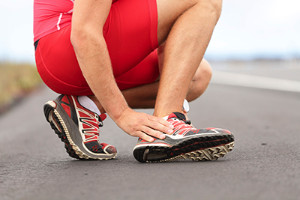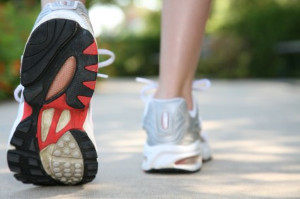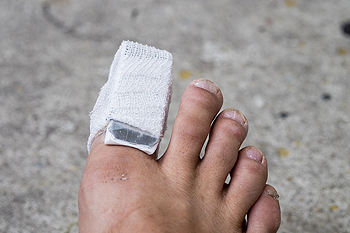Blog
How Is An Ankle Sprain Diagnosed?
 There are ligaments that connect the bones of the feet to the ankle. If an injury occurs and tears or stretches one or more of these ligaments, it may result in an ankle sprain. It typically happens if the ankle is twisted or rolled in an abnormal manner, and the ligaments are pushed past their normal range of motion. Some of the symptoms that are typically associated with a sprained ankle can consist of extreme swelling, severe pain and discomfort, and it is generally difficult to walk. Additionally, the ankle may appear to be bruised, and it may become stiff. A proper diagnosis will often involve having an X-ray taken, which is necessary to rule out a broken ankle. Mild relief can be found when the affected ankle is elevated, and an elastic bandage is wrapped around the ankle which may be helpful in providing support. If you have fallen and twisted your ankle, please speak to a podiatrist who can guide you toward beginning the correct treatment.
There are ligaments that connect the bones of the feet to the ankle. If an injury occurs and tears or stretches one or more of these ligaments, it may result in an ankle sprain. It typically happens if the ankle is twisted or rolled in an abnormal manner, and the ligaments are pushed past their normal range of motion. Some of the symptoms that are typically associated with a sprained ankle can consist of extreme swelling, severe pain and discomfort, and it is generally difficult to walk. Additionally, the ankle may appear to be bruised, and it may become stiff. A proper diagnosis will often involve having an X-ray taken, which is necessary to rule out a broken ankle. Mild relief can be found when the affected ankle is elevated, and an elastic bandage is wrapped around the ankle which may be helpful in providing support. If you have fallen and twisted your ankle, please speak to a podiatrist who can guide you toward beginning the correct treatment.
Ankle sprains are common but need immediate attention. If you need your feet checked, contact one of our podiatrists from James Kutchback, DPM, CWS-P. Our doctors can provide the care you need to keep you pain-free and on your feet.
How Does an Ankle Sprain Occur?
Ankle sprains take place when the ligaments in your ankle are torn or stretched beyond their limits. There are multiple ways that the ankle can become injured, including twisting or rolling over onto your ankle, putting undue stress on it, or causing trauma to the ankle itself.
What Are the Symptoms?
- Mild to moderate bruising
- Limited mobility
- Swelling
- Discoloration of the skin (depending on severity)
Preventing a Sprain
- Wearing appropriate shoes for the occasion
- Stretching before exercises and sports
- Knowing your limits
Treatment of a Sprain
Treatment of a sprain depends on the severity. Many times, people are told to rest and remain off their feet completely, while others are given an air cast. If the sprain is very severe, surgery may be required.
If you have suffered an ankle sprain previously, you may want to consider additional support such as a brace and regular exercises to strengthen the ankle.
If you have any questions please feel free to contact our offices located in The Woodlands and Woodville, TX . We offer the newest diagnostic tools and technology to treat your foot and ankle needs.
Podiatry As A Career
 The growing need for foot care can be seen in all age groups across the globe. Podiatrists specialize in ailments that affect the feet and ankles, in addition to performing surgery. They generally finish a four year program, followed by completing a hospital residency. The choice of a working environment can range from private practice to long-term care facilities. Research has indicated the number of podiatrists will increase significantly in the future, which may be a result of people becoming more aware of specific foot conditions, and the necessity of receiving proper treatment. If you would like to pursue a career in podiatry, please consult with a podiatrist who can help you to determine if this is a correct career path for you.
The growing need for foot care can be seen in all age groups across the globe. Podiatrists specialize in ailments that affect the feet and ankles, in addition to performing surgery. They generally finish a four year program, followed by completing a hospital residency. The choice of a working environment can range from private practice to long-term care facilities. Research has indicated the number of podiatrists will increase significantly in the future, which may be a result of people becoming more aware of specific foot conditions, and the necessity of receiving proper treatment. If you would like to pursue a career in podiatry, please consult with a podiatrist who can help you to determine if this is a correct career path for you.
If you are experiencing pain in the feet or ankles, don’t join the stubborn majority refusing treatment. Feel free to contact one of our podiatrists from James Kutchback, DPM, CWS-P. Our doctors can provide the care you need to keep you pain-free and on your feet.
What Is a Podiatrist?
Someone would seek the care of a podiatrist if they have suffered a foot injury or have common foot ailments such as heal spurs, bunions, arch problems, deformities, ingrown toenails, corns, foot and ankle problems, etc.
Podiatric Treatment
A podiatrist will treat the problematic areas of the feet, ankle or lower leg by prescribing the following:
- Physical therapy
- Drugs
- Orthotic inserts or soles
- Surgery on lower extremity fractures
A common podiatric procedure a podiatrist will use is a scanner or force plate which will allow the podiatrist to know the designs of orthotics. Patients are then told to follow a series of tasks to complete the treatment. The computer will scan the foot a see which areas show weight distribution and pressure points. The podiatrist will read the analysis and then determine which treatment plans are available.
If you have any questions, please feel free to contact our offices located in The Woodlands and Woodville, TX . We offer the newest diagnostic and treatment technologies for all your foot care needs.
Can Practicing Yoga Help to Prevent Running Injuries?
Research has indicated it is beneficial to perform specific stretching techniques that may be helpful in preventing running injuries. It is wise to choose running shoes that fit correctly, assuring the heel and toes feel comfortable. The joints, muscles, and tendons can remain flexible when yoga is routinely practiced, which may help to increase the enjoyment of running. Additionally, many runners practice strength training, this can keep the muscles strong which may add to endurance. Any tension that is present may be alleviated when a massage is performed, helping this to aid the body in feeling relaxed. If you are contemplating the sport of running, it is suggested that you speak to a podiatrist who can advise you on how to prevent running injuries.
All runners should take extra precaution when trying to avoid injury. If you have any concerns about your feet, contact one of our podiatrists of James Kutchback, DPM, CWS-P. Our doctors will treat your foot and ankle needs.
How to Prevent Running Injuries
There are a lot of mistakes a runner can make prior to a workout that can induce injury. A lot of athletes tend to overstretch before running, instead of saving those workouts for a post-run routine. Deep lunges and hand-to-toe hamstring pulls should be performed after a workout instead of during a warmup. Another common mistake is jumping into an intense routine before your body is physically prepared for it. You should try to ease your way into long-distance running instead of forcing yourself to rush into it.
More Tips for Preventing Injury
- Incorporate Strength Training into Workouts - This will help improve the body’s overall athleticism
- Improve and Maintain Your Flexibility – Stretching everyday will help improve overall performance
- “Warm Up” Before Running and “Cool Down” Afterward – A warm up of 5-10 minutes helps get rid of lactic acid in the muscles and prevents delayed muscle soreness
- Cross-Training is Crucial
- Wear Proper Running Shoes
- Have a Formal Gait Analysis – Poor biomechanics can easily cause injury
If you have any questions, please feel free to contact our offices located in The Woodlands and Woodville, TX . We offer the newest diagnostic and treatment technologies for all your foot care needs.
What is PAD?
 The medical term that is known as peripheral arterial disease (PAD) is described as excess fatty deposits in the arteries. This condition may inhibit blood supply to the feet, and it may be difficult to walk. Patients who are afflicted with PAD may experience a loss of feeling or a tingling sensation in the feet and legs, open sores which do not heal in a timely fashion, and the nails may become brittle. There are a variety of reasons why this condition may occur. These can consist of smoking, having elevated blood pressure, or being diabetic. Painful symptoms may be gradually diminished when gentle stretching techniques are frequently practiced, in addition to implementing healthy eating habits. If you are suffering from PAD, it is recommended that you consult with a podiatrist who can help you to manage this ailment.
The medical term that is known as peripheral arterial disease (PAD) is described as excess fatty deposits in the arteries. This condition may inhibit blood supply to the feet, and it may be difficult to walk. Patients who are afflicted with PAD may experience a loss of feeling or a tingling sensation in the feet and legs, open sores which do not heal in a timely fashion, and the nails may become brittle. There are a variety of reasons why this condition may occur. These can consist of smoking, having elevated blood pressure, or being diabetic. Painful symptoms may be gradually diminished when gentle stretching techniques are frequently practiced, in addition to implementing healthy eating habits. If you are suffering from PAD, it is recommended that you consult with a podiatrist who can help you to manage this ailment.
Peripheral artery disease can pose a serious risk to your health. It can increase the risk of stroke and heart attack. If you have symptoms of peripheral artery disease, consult with one of our podiatrists from James Kutchback, DPM, CWS-P. Our doctors will assess your condition and provide you with quality foot and ankle treatment.
Peripheral artery disease (PAD) is when arteries are constricted due to plaque (fatty deposits) build-up. This results in less blood flow to the legs and other extremities. The main cause of PAD is atherosclerosis, in which plaque builds up in the arteries.
Symptoms
Symptoms of PAD include:
- Claudication (leg pain from walking)
- Numbness in legs
- Decrease in growth of leg hair and toenails
- Paleness of the skin
- Erectile dysfunction
- Sores and wounds on legs and feet that won’t heal
- Coldness in one leg
It is important to note that a majority of individuals never show any symptoms of PAD.
Diagnosis
While PAD occurs in the legs and arteries, Podiatrists can diagnose PAD. Podiatrists utilize a test called an ankle-brachial index (ABI). An ABI test compares blood pressure in your arm to you ankle to see if any abnormality occurs. Ultrasound and imaging devices may also be used.
Treatment
Fortunately, lifestyle changes such as maintaining a healthy diet, exercising, managing cholesterol and blood sugar levels, and quitting smoking, can all treat PAD. Medications that prevent clots from occurring can be prescribed. Finally, in some cases, surgery may be recommended.
If you have any questions, please feel free to contact our offices located in The Woodlands and Woodville, TX . We offer the newest diagnostic and treatment technologies for all your foot care needs.
Ankle Injury Forced Falcons Quarterback to Leave the Game
 The Falcon’s quarterback Matt Ryan was tackled several times during their game on October 20th. The last sack resulted in an ankle injury that forced him to exit the game. After rolling on the ground, getting up, and limping, he was checked by the medical team. Dan Quinn, who is the Falcon’s coach will have a better idea of if he can return to play for future games. The back-up quarterback Matt Schaub quickly entered the game, and was able to throw a touchdown pass in the fourth quarter. The final score was in favor of the Rams, 37-10.
The Falcon’s quarterback Matt Ryan was tackled several times during their game on October 20th. The last sack resulted in an ankle injury that forced him to exit the game. After rolling on the ground, getting up, and limping, he was checked by the medical team. Dan Quinn, who is the Falcon’s coach will have a better idea of if he can return to play for future games. The back-up quarterback Matt Schaub quickly entered the game, and was able to throw a touchdown pass in the fourth quarter. The final score was in favor of the Rams, 37-10.
Ankle and foot injuries are common among athletes and in many sports. They can be caused by several problems and may be potentially serious. If you are feeling pain or think you were injured in a sporting event or when exercising, consult with one of our podiatrists from James Kutchback, DPM, CWS-P. Our doctors will assess your condition and provide you with quality foot and ankle treatment.
Common Injuries
The most common injuries that occur in sporting activities include:
- Achilles Tendonitis
- Achilles Tendon Rupture
- Ankle Sprains
- Broken Foot
- Plantar Fasciitis
- Stress Fractures
- Turf Toe
Symptoms
Symptoms vary depending upon the injury and in some cases, there may be no symptoms at all. However, in most cases, some form of symptom is experienced. Pain, aching, burning, bruising, tenderness, tightness or stiffness, sensation loss, difficulty moving, and swelling are the most common symptoms.
Treatment
Just as symptoms vary depending upon the injury, so do treatment options. A common treatment method is known as the RICE method. This method involves rest, applying ice, compression and elevating the afflicted foot or ankle. If the injury appears to be more serious, surgery might be required, such as arthroscopic or reconstructive surgery. Lastly, rehabilitation or therapy might be needed to gain full functionality in the afflicted area. Any discomfort experienced by an athlete must be evaluated by a licensed, reputable medical professional.
If you have any questions please contact our offices located in The Woodlands and Woodville, TX . We offer the newest diagnostic and treatment technologies for all your foot and ankle needs.
Mild and Severe Broken Toes
Many patients are aware they have broken their toe by the severe pain and discomfort they feel after something heavy is dropped on it. It may also become fractured if it has been stubbed against a piece of furniture. Additional symptoms can include a numbing or burning feeling, bruising, and walking can become difficult. In serious fractures, the bone may protrude from the skin, and there may even be excessive bleeding. Broken toes can occur as a result of a medical condition such as osteoporosis, where the bones may already be fragile. After a proper diagnosis is performed, which typically consists of having an X-ray taken, treatment can begin. If the toe is mildly broken, it can be taped to the toe next to it, and this may be helpful in providing additional support. This method is referred to as buddy taping. It is strongly recommended that you consult with a podiatrist who can correctly treat broken toes.
A broken toe can be very painful and lead to complications if not properly fixed. If you have any concerns about your feet, contact one of our podiatrists from James Kutchback, DPM, CWS-P. Our doctors will treat your foot and ankle needs.
What to Know About a Broken Toe
Although most people try to avoid foot trauma such as banging, stubbing, or dropping heavy objects on their feet, the unfortunate fact is that it is a common occurrence. Given the fact that toes are positioned in front of the feet, they typically sustain the brunt of such trauma. When trauma occurs to a toe, the result can be a painful break (fracture).
Symptoms of a Broken Toe
- Throbbing pain
- Swelling
- Bruising on the skin and toenail
- The inability to move the toe
- Toe appears crooked or disfigured
- Tingling or numbness in the toe
Generally, it is best to stay off of the injured toe with the affected foot elevated.
Severe toe fractures may be treated with a splint, cast, and in some cases, minor surgery. Due to its position and the pressure it endures with daily activity, future complications can occur if the big toe is not properly treated.
If you have any questions, please feel free to contact our offices located in The Woodlands and Woodville, TX . We offer the newest diagnostic and treatment technologies for all your foot care needs.
What Causes Toenail Fungus To Develop?
 Research has indicated that approximately half of the population is affected with nail fungus, and it is most likely to occur in the toenails. It is caused by a fungal infection, and typically develops in the big toe. There are several symptoms that are associated with this ailment. These can include a yellowing of the nail, and it may appear brittle and dull. In severe cases, the nail may produce a foul odor, and can lift from the nail bed. The fungus that causes this contagious condition lives and thrives in warm and moist areas. These can consist of public swimming pools and locker room floors. There may be preventive measures that can be taken that can include wearing appropriate shoes while in these types of environments, in addition to wearing shoes and socks that are made of a breathable material. If you notice a toenail fungus is developing, it is suggested that you schedule a consultation with a podiatrist who can offer you proper treatment techniques.
Research has indicated that approximately half of the population is affected with nail fungus, and it is most likely to occur in the toenails. It is caused by a fungal infection, and typically develops in the big toe. There are several symptoms that are associated with this ailment. These can include a yellowing of the nail, and it may appear brittle and dull. In severe cases, the nail may produce a foul odor, and can lift from the nail bed. The fungus that causes this contagious condition lives and thrives in warm and moist areas. These can consist of public swimming pools and locker room floors. There may be preventive measures that can be taken that can include wearing appropriate shoes while in these types of environments, in addition to wearing shoes and socks that are made of a breathable material. If you notice a toenail fungus is developing, it is suggested that you schedule a consultation with a podiatrist who can offer you proper treatment techniques.
For more information about treatment, contact one of our podiatrists of James Kutchback, DPM, CWS-P. Our doctors can provide the care you need to keep you pain-free and on your feet.
Toenail Fungus Treatment
Toenail fungus is a condition that affects many people and can be especially hard to get rid of. Fortunately, there are several methods to go about treating and avoiding it.
Antifungals & Deterrence
Oral antifungal medicine has been shown to be effective in many cases. It is important to consult with a podiatrist to determine the proper regiment for you, or potentially explore other options.
Applying foot powder on the feet and shoes helps keep the feet free of moisture and sweat.
Sandals or open toed shoes – Wearing these will allow air movement and help keep feet dry. They also expose your feet to light, which fungus cannot tolerate. Socks with moisture wicking material also help as well.
If you have any questions please contact our offices located in The Woodlands and Woodville, TX . We offer the newest diagnostic and treatment technologies for all your foot and ankle needs.








